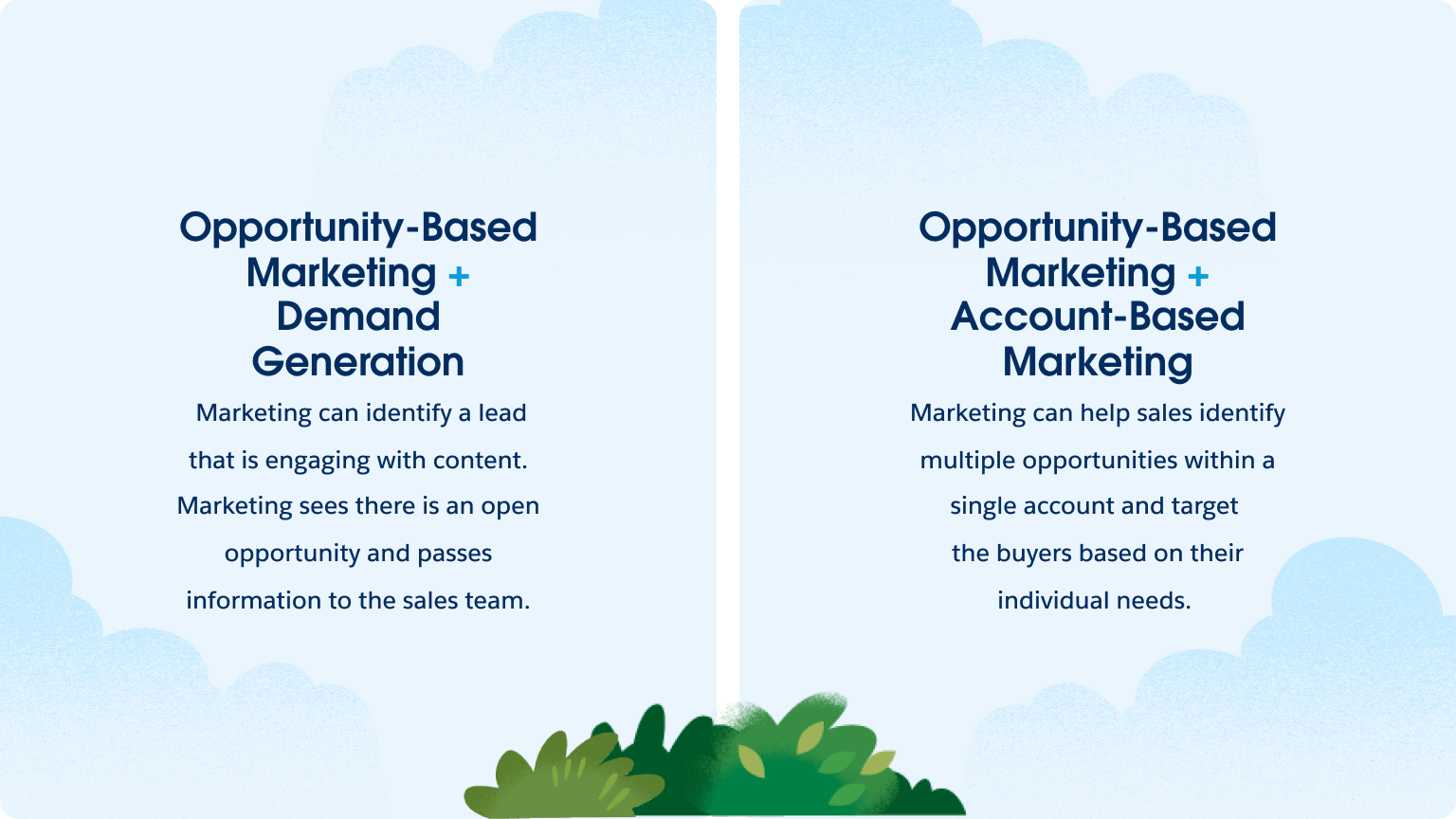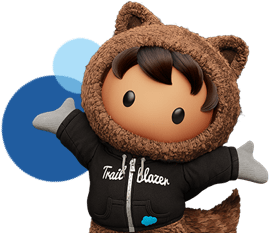Opportunity-Based Marketing for B2B Marketers
Align with sales and turn your opportunities into customers.
Table of Contents
In this guide, we’ll break down how to develop an OBM (Opportunity-Based Marketing) approach, including strategies for implementation, techniques for outreach, and specific ways OBM complements ABM and demand generation.
What is Opportunity-Based Marketing?
“It’s time for B2B marketers to make the shift from leads to buying groups and opportunities.”

The marketing team then tailors marketing campaigns, messaging, and content to address these opportunities. This also includes resources — such as sales collateral, case studies, and testimonials — that sales teams can use to reinforce value propositions and build credibility.
If marketing teams are aware of opportunities, they can assist in the early and closing stages of the sales process by delivering relevant and timely messaging to the buying group.
Why is Opportunity-Based Marketing important?
There also might be more than one buying group within an account — requiring different product offers based on different needs. For example, let’s say you sell textbooks and your account is Salesforce University. There are many different departments within the university — biology, mathematics, public health, and so on. You wouldn’t target the biology department with ads for mathematics books and vice versa.
Without a clear understanding of your lead’s role in the decision-making process, you risk wasting time and money on irrelevant marketing campaigns and sales outreach. This is where opportunity-based marketing shines.
Why should marketers consider Opportunity-Based Marketing?
“These B2B buyers start as a group well before they hit your website or respond to your marketing efforts.”
B2B marketing and sales teams focus on opportunities for a number of different reasons:
- Your company sells multiple products, and the sales team has opportunities for individual offers.
- Your target accounts have multiple buying committees and decision makers.
- The opportunity includes multiple people across accounts. For example, let’s say you’re selling solar panels for a new office building. You’ll not only need to get the account on board, but you’ll also likely need to gain support from a contractor and building supply person.
If you find yourself relating to one or more of these scenarios, here are a few benefits of using an OBM approach:
Flexibility: Marketers can be flexible and adapt quickly to changing market conditions, customer needs, and emerging trends with OBM. This agility enables them to seize opportunities as they arise and stay ahead of the competition.
Relevance: By closely aligning marketing efforts with existing opportunities identified by sales teams, marketers can ensure that their messages and offerings are highly relevant to the target audience. This increases the likelihood of engaging prospects and driving conversions.
Efficiency: Focusing on existing opportunities can lead to more efficient use of resources, as marketers allocate their time, budget, and efforts towards initiatives that have a higher likelihood of success. This can result in a better return on investment (ROI) for marketing activities.
Customer-centricity: By tailoring marketing messages and offerings to address specific needs, marketers can build stronger relationships with customers and enhance brand loyalty.
Collaboration: By leveraging respective sales and marketing expertise, teams can drive mutual success.
Strategies for Implementation
What’s our biggest tip to get started? Start small. Whether you’re looking for an easy shift (crawl) or a data overhaul (run), here is how you can get started using Salesforce:
How it works: Pulling in information from CRM based on opportunity data (stage, decision makers, job function, etc.), the sales team manually identifies individuals within a buying committee and aligns them to an opportunity. Here, both sales and marketing gain a deeper understanding of each individual’s interest and needs.
Benefits: This approach is easy to implement and requires little change management.
Benefits: Perhaps the most enticing benefit of this method is the ability to pull in all of your marketing data for a more comprehensive view of all marketing efforts so you can better prove ROI. This not only allows marketers to make smarter decisions, but it results in all revenue teams gaining a better understanding of marketing’s effectiveness and impact on revenue. In addition, this approach streamlines processes as all teams are working from the same data. There is no handover process, and buying signals are acted on quickly — accelerating pipeline growth.
Boost Your Productivity with AI

With innovations in AI, Opportunity-Based Marketing is set to become more feasible for marketers. With generative AI, you can create personalized content quicker by getting started with prompts instead of manually building out templates. Predictive lead and behavior scoring can help marketers identify prospects who might belong to the buying group. You can also use AI to segment, using categories such as opportunity status and job title.
However, AI is only as good as your data. To successfully implement OBM, tight alignment between marketing and sales is required — including access to shared, trusted data and real-time updates across sales and marketing efforts.
Techniques for Outreach
Segmentation is key in oppportunity-based marketing. With Salesforce, you can segment opportunities to better tailor your outreach. Here are a few ways Marketing Cloud Account Engagement helps you do so specifically:
- Use custom dashboards to track marketing influenced pipeline movement by stage.
- Use scoring categories to track a prospect/lead’s interest in a product (if multiple).
- Use engagement history dashboards and lead scoring to surface insights about who could be a champion on the committee and track a prospect’s overall interest.
- Use sales emails and alerts to message individuals on the buying committee and track this information in the Salesforce ecosystem.
- Dynamic lists can help marketers identify prospects who might belong to the buying group and creative personalized journeys based on this information.
How Opportunity-Based Marketing works with Demand Generation and ABM
Top Priorities for Success

Of sales and marketing decision makers agree that misalignment between sales and marketing teams damages financial performance.
It is important to define shared goals from the start. Here are a few ways to do that:
- Align marketing and sales team efforts. Clear and open lines of communication and understanding of each team’s priorities are crucial. Check out best practices here.
- Remove data silos between sales and marketing. For OBM to be successful, marketing and sales teams must share data in real-time. This is especially critical as more automation is introduced in each phase of opportunity-based marketing.
- Collaborate to create shared KPIs. Bringing key stakeholders along in your strategy is important. Determine how performance is measured — pipe, ACV, ROI, etc. — and align on steps to get there.
- Start the conversation now. Marketing can set the tone on buyer trends. Advocate for change and educate your sales teams on the value of OBM, like this Forrester webinar.
In a world where market landscapes are constantly shifting and customer preferences evolving, opportunity-based marketing emerges as a beacon of agility and relevance. By embracing this dynamic approach, marketers not only seize the moment but also forge stronger connections with their audience, fueled by insights and collaboration. Opportunity-based marketing isn't just about chasing trends; it's about shaping them, leveraging every moment to drive growth, innovation, and lasting impact.

State of Marketing

Salesforce named a Leader in 2024 Gartner® Magic Quadrant™ for B2B Marketing Automation Platforms.

B2B Marketer's Guide to Winning Customers and Proving Success
About the Author
.jpg)
Megan Cohn
Senior Product Marketing Manager, Salesforce
More resources

Build a winning ABM strategy. Learn how.

Elevate your B2B marketing with AI. Watch now.






